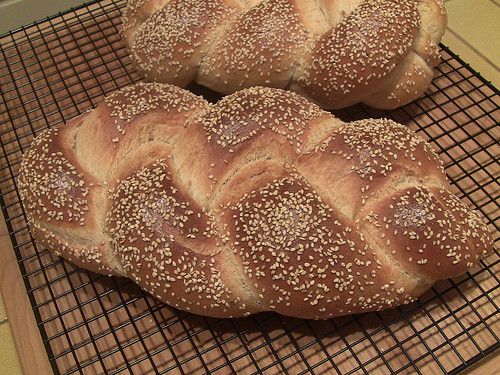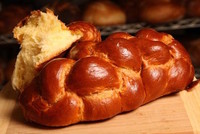Challah from a winter oven: Nothing’s better!
Challah is so important to Shabbos that, if a family cannot afford both wine and challah, the challah is considered the more important item.
There are many commandments and customs surrounding this ancient food. The word, “challah,” actually means the piece of dough taken before the bread is baked. In Bamidbar 15:17-21, G-d commands Moses to tell the Israelites to set aside a piece of dough as a gift for the L-rd. We take a small piece of raw challah dough and, before baking the loaves, burn it to represent the Biblical offerings. We place two challot on the Shabbos table to remind us of the double portion of manna that was given to us in the desert on Shabbos.
Challot usually come in two shapes: the traditional three-braid challah and, on the High Holidays, the round challah we eat to symbolize the seamlessness of time. But challah can be intricately woven from as many as 10 strands. Before the pre-fast meal on Yom Kippur, some people eat a bird-shaped challah to symbolize the belief that a bird will carry away our sins. People also make challot in the shapes of ladders, dreidels and even fish.
There is nothing like homemade challah. And in the winter, there is nothing like the heady aroma of rising dough and baking bread filling the house on a Friday. Making challah is not difficult, and it’s a wonderful family activity to help usher in Shabbos.
SOME CHALLAH HINTS:
•Always use fresh yeast, which has been refrigerated. Yeast is a key player in bread making. It essentially eats the sugar and releases carbon dioxide and alcohol, which make the bread rise and adds flavor to the flour.
•Make sure the liquid you use is between 100 and 115 degrees. If the water is too cold, the yeast will be sluggish and will not fully rise. If it is too hot, the yeast will die. I have found 110 degrees to be prefect.
•Be patient and let the dough rise the full amount of time.
•Knead enthusiastically, using the heel of your hand to push the dough. Great exercise and a great stress reliever!
•Dough is fully risen when you insert two fingers about an inch deep into the dough and the indentation remains. If the indentation bounces right back up, it needs more rising time.
•Don’t be afraid to really punch the dough (my kids loved this part!). It helps deflate the excess gasses and helps create a finer texture.
•The baked challah sounds hollow when tapped on the bottom. I really had no idea what that meant when I first started making bread, but I learned that it is a dull, thud-like, sound as opposed to a sharp sound like when you tap on a solid door. Don’t worry, “bake until golden” usually works. However, the “golden” should be more of an oak color, not a butter color.
Jenny’s Favorite Challah (Pareve)
Decades ago, I decided to try to create a really good challah recipe. Each week I tried a different version and, like in “Goldilocks and the Three Bears,” some were too hard, some were too soft and some tasted like, well, we ate a lot of French toast. Finally, one Friday evening, my then three- year-old declared, upon tasting this particular challah, that it was her “most favorite” and I was to make only this one from now on. Thus, Jenny’s Favorite Challah was created and, now, decades later, it is still our favorite, traditional challah. Make it with your children or grandchildren and let them make their own braided creations. Children are great “kneaders!”
2 envelopes dry active yeast
1-/3 cups warm water (105 to 110 degrees)
4 extra-large eggs, slightly beaten
1/2 cup sugar
2 tsp. salt
1/2 cup Canola oil
8 to 9 cups unbleached flour
1 egg yolk
1 tbsp. water
OPTIONAL: poppy seeds, “everything” topping, sesame seeds. Etc.
Corn meal for the baking tray
Dissolve the yeast in the warm water in the bowl of an electric mixer. Add a teaspoon of the sugar, mix well and let it proof for about 5 minutes. You should see foam on top and moving bubbles all around. Add the beaten eggs, the rest of the sugar, the salt and oil. Mix with a dough hook on a very slow speed. While on slow, add flour, one cup at a time, beating well after each cup. Add all the flour and mix with the dough hook until all the flour is incorporated and the dough pulls away from the sides of the bowl and sticks together. You may need to increase speed a bit.
Remove the dough to a floured surface and knead by hand for 5 to 10 minutes until the dough is silky smooth. Form into a large ball and place in a large oiled bowl. Turn the oiled side up, cover with a dishtowel and set in a warm place for two hours or until doubled in size.
Punch down the dough, knead for 2 to 3 minutes, and return to the oiled bowl, turning the oiled side up and covering with the towel. Let rise one hour.
Divide the dough into thirds and then divide each piece into thirds. Roll each piece into a rope about 12-14 inches long. Braid each loaf with a three or four braid pattern. Place each loaf on a cookie sheet that has been generously sprinkled with cornmeal. Cover and let rise in a warm place for 90 minutes.
Mix the egg yolk with the tablespoon of water and brush the tops of the loaves with this mixture. If you like, sprinkle with your choice of seeds. Bake at 375 degrees for 25 to 35 minutes or until deep golden brown. Makes 2 to 3 loaves.
Honey Whole Wheat Challah (Pareve)
This wonderful challah needs to rise 3 times, but the results are a light and delicious challah.
1-1/2 cups warm water
2 packages dry yeast
1/4 cup plus 1 tbsp. sugar
1 tsp. salt
1/3 cup honey
1/3 cup canola oil
3 extra large eggs
3 cups whole wheat flour
3 to 4 cups unbleached flour
1 beaten egg
OPTIONAL: golden raisins, sesame or poppy seeds
Put the yeast, water, and tablespoon of sugar in a large bowl. Mix well and let stand for about 5 minutes, until the yeast starts to bubble. Add the honey, remaining sugar, salt, oil and eggs. Whisk until blended. Add the whole wheat flour and most of the white flour and mix well. Knead for about 10 to 12 minutes until the dough is smooth and elastic. Add the raisins and knead them in well.
Place in a lightly greased bowl and flip so that the oiled side is up. Cover with a towel or plastic wrap. Set in a warm place to rise for 90 minutes to 2 hours or until doubled in bulk. Gently press down the dough and divide it into three or 6 long strands. Braid the challah (challot) and place on a baking sheet lined with parchment paper or cornmeal. Cover and let rise for 1 hour or until almost doubled in size.
Gently brush the loaf (loaves) with the egg and sprinkle poppy or sesame seeds over the egg wash. Cover and allow to rise once more for about 30 to 40 minutes. Preheat the oven to 350 degrees and bake for 25-35 minutes until deep golden brown. Makes 1 to 2 loaves.

 50.0°,
Overcast
50.0°,
Overcast 







